Last Updated: 16 April 2007

Cellars
In the photograph of Alfred Hein, which shows the inside of a GR building in Russia and the floors, there was, also, trap doors that lead down into a cellar. So, I asked about cellars.
![]()
Evidently, there were a variety of cellars dug in some of the Bess. properties. As I mentioned in my last e-mail, the Peterstal building has a cellar inside the building / home. Some had entry outside the home..... I assume the size differed from home to home. Anyone have any stories about their family cellar..... If under the home, I assume there were beams and other wood planks to support the floor.... Yes? No? Did the areas near Odessa have cellars? Volga? Crimea? Caucasus?
![]()
In a message dated 6/11/03 7:04:16 PM, cathylsagebiel@earthlink.net writes:
<< I've attached 2 small pictures of the outside cold storage cellar located on my grandfather's farm in Dickey County, ND. The pictures were taken in the early 1940's. My father said it went underground and stayed a consistent 50-60 degrees F year-round. I can only assume this structure may have some relevance to how the outside cellars in Bessarabia were built, since both my Grandma and Grandpa left Borodino and Beresina, respectively, in 1911. I do not have any more info on the building of this cellar, however, I can ask my dad what he remembers. Also, he has told me a few stories about getting in trouble for playing in the cellar....>>
Cathy Sagabiel
Bippus family descendent >>
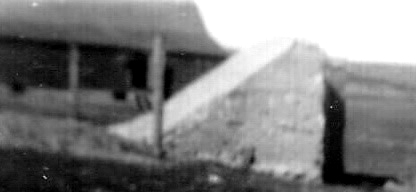
Jacob Hartman's Cold Storage Cellar, Dickey County, ND, USA
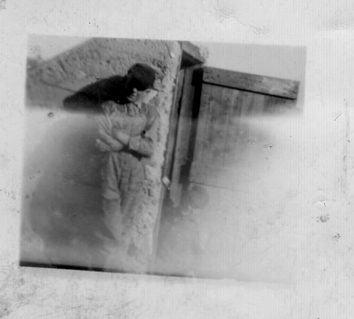
There are two people.
One standing outside and the other looks as if he's standing on steps and is partly down into the cellar.
Jacob Hartmann's Farm, Dickey County, ND, USA.
![]()
In a message dated 6/11/03 1:48:44 PM, beektabeek@msn.com writes:
<< ...Actually my grandparents had TWO root cellars. One was located outside of the house. There was a building built over it where other farm and household items were stored. It was quite a large building, and there was a hole in the ground inside the building that was covered over by a "trap door" in the floor. Once you opened the trap door, there was a ladder "stair" going down into the hole and there were wooden shelves built on all four walls to hold vegetables, fruits, potatoes, and canned goods. And there was one root cellar that was located under the house. There was a trap door cut into the floor in the "family room." The house consisted of three large rooms downstairs and two up. One room was the kitchen and it was located running east to west the entire length of the house and was a rather thin room. The rest of the bottom floor was divided into two rooms...the one on the east was the bedroom/living room with a couch and the one on the west was the family room. It contained the dining table and it was what we would now consider a combination dining room and family room. This is the room where all the socializing (with the exception of special Sunday company) was done. At the end of the table, and near the door to the kitchen, there was a hole cut into the flooring and it was covered with the same linoleum as the rest of the floor. The trap door had a ring that was embedded into the door, so that it sat even with the level of the floor. To open the door, you had to pull up the ring, and pull the door upwards. The door was then simply laid back onto the adjacent floor. My mom said they had a chain attached on one end to the door and the other to the floor that kept the door from laying flat back onto the floor so you didn't have to open it all the way, but I don't recall it ever being there when I was a kid (perhaps my memory is faulty there...) Once the door was open, there was a straight up and down wooden "ladder" that you stepped onto to descend into the cellar. The cellar was simply a rather squarish hole dug into the ground under the house. The "walls" were dirt and there were wood shelves that were set on the floor running from dirt floor to ceiling on all of the walls with the exception of where the ladder was. I don't know if these shelves were anchored in any way to the "walls" but I do remember that they were nailed to the "ceiling" with wood posts. These shelves were packed with things from the garden, fruits, vegetables, and the potatoes, because of their size and weight were lined up in burlap bags all along the floor under the bottom shelf. The shelves were also lined with jars and jars of Grandma's canning goods as well as boxes of empty jars, lids, and rings. Grandma also kept her canning kettles, etc down there.
I remember that us kids were often chosen to go down into the cellar and bring up one thing or another. It was always nice and cool down there, even during the hottest days. There was an electric light down there, and once you were on the ladder, you could reach the string to pull the light switch on. I don't recall that you were able to reach the string by laying on the floor and turning the light on before you got onto the ladder (which I am thinking I would have remembered...) My mom said prior to the light being installed down there, they used a kerosene lamp to light the hole for whomever was going down and then the lamp was passed down once the person who was send down was at floor level. The cellar wasn't very deep, but deep enough to have, as I recall, at least 5 shelves far enough apart to hold canning jars. The area between the floor and the first shelf was taller than the rest and so was the area between the top shelf and the ceiling. Heavy items went onto the floor and taller, less heavy items on the top shelf. Onions and garlic were braided together and hung on nails pounded into the upright posts that the shelves were attached to. As I said, the floor was just dirt, and by my time, it was pretty compacted from years of use. The walls were somewhat crumbling dirt, although I rarely saw any dirt clods or places where the walls had crumbled dirt onto the floor. One of our "jobs" when we were down there was to do a quick inspection of the conditions of the walls and shelves and let Grandpa know if we saw anything out of order...sagging shelves, crumbling walls, etc.
The ceiling was as you suspected, the bottom of the floor. You could see the floor joists (is that what they are called?) running across the "ceiling" and you could see the wood slats that made up the floor. Since the floor was covered with linoleum (remember that old linoleum, or was it even called that back then, that had the black, almost tar backing? That was what was on the floor in all of the house...) you couldn't see any light or anything through the flooring and it was pitch black down there when the light was off and the trap door shut.
There were always spider webs everywhere, so it was MY habit to get down to floor level, then survey the "premises" and find out which webs had spiders in them, locate the item I needed, and find the best "path" to the item without disturbing tooo many of the spiders in the process! I do recall occasionally find dead mice in the potato bags (UGH!!!!!) so I was always careful to make sure I could see into the bag before I stuck my hand in it! (I made the mistake of doing that ONCE and came out with a rather large dead mouse instead of a potato. I bet you didn't know mice could fly, did you?? Well, they can if you have the proper motivation to get that THING out of your hand as QUICKLY as possible!! We had to bring any dead mice we found up with us, but as I recall, I never DID find that flying mouse and didn't make a very good attempt to find it either...don't tell Grandma!! ;-)
Also, I do recall on one occasion the I had been sent to get something and I reached for the jar off the shelf and saw something move. I yanked my hand back, thinking it was probably a mouse, but it wasn't. There was a small garden snake wrapped around the bottom of the jar I was going to pick up (learned my lesson on that one too...never pick anything up BEFORE you inspect it!) After I got my breathing under control, I thanked God that there was more than one jar of what I wanted and I very quickly selected the farthest jar from the snake, yanked it off the shelf, and was up the ladder before you could say "Boo!" I remember my mom asking why I was up the ladder so quick, and I simply said, "Garden snake." and she didn't say anything more! If I recall correctly though, Grandpa went down into the cellar and got it and put it outside.
Let me know if you have any more questions and I'd be happy to find out if I don't know...I can always ask my Mom for more details. I'm sure she spent more time down there than I did! Also, I might have pictures somewhere of the outdoor root cellar building, but you might be disappointed with that...just looks like a regular building...red paint, white trim like the barn. I also MIGHT have a picture of the trap door in the house. I remember on one trip taking pictures of the weirdest things in the house for memories and I seem to recall taking one of the trap door at one time. If not, the house is still standing and I'm sure my aunt or uncle would be happy to snap a picture next time they are out there.
Deb>>
![]()
In a message dated 6/11/03 2:55:42 PM, cp.ee.jinks@worldnet.att.net writes:
<< I can't speak for the cellars in Bessarabia. But my father and grandfather emigrated from Gnadenfeld, Bessarabia to Alberta, Canada in 1910. In the Canadian home which my father and I grew up in had a cellar which could be entered from inside the home. It was like a trap door which was part of the floor structure. Each evening it was lifted so our cat, fluffy, could go to her abode for the night. The cellar also had an entrance from outside. My grandfather built the house. In that my father grew vegetables for a Chinese restaurant, many vegetables were stored in the cellar for the restaurant and family use in the winter months.
The house is still lived in and from outward appearance has changed very little. Someday it may be on a historical register. It is in a subdivision of new houses.
Elizabeth Schneider Jinks>>
![]()
In a message dated 6/14/03 11:50:39 AM, wisdomaker@earthlink.net writes:
<< ...When I was in Friedenstal, I saw two outdoor cellars. I have photo of one, from the outside of course. It would have been rude to invite myself inside. This family provided a impromptu- lunch for us. I have no other information than that.
Marge >>
![]()
Edwin and Lillian, nee Hein, Remmick Interview 14 June 2002 by daughter Judy, A. Remmick-Hubert:
Lillian: We had two kinds of cellars in Montana. There was the cellar under the house which had a trap door from inside the house so it was easier to reach while we cooked and baked. This had the root vegetables like potatoes, carrots, melons.... Oh, I remember Mother's, " [Christina, nee Schweikert, Hein's] huge crockery filled with pickled watermelons and of course there were the pickles and the sauerkraut..."
Judy: I remember the sauerkraut you [Mom] use to make. We had these huge crock' containers under the wash sink.... You know what, the only place that had the same tasting sauerkraut as yours Garry [Judy's husband] found in Berlin at a small restaurant, Hardthe. The instant I tasted it, it took my memory straight back to your sauerkraut, Mom.
Mom (smiling): It did?
Judy: Yes
Ed: It was good eating.
Mom: My Mother was a better cook than I or anyone from here to Russia. I remember the neighbors stopping by to eat her breads and pies.... and those pickled watermelons which she would usually save for one of those hot Sunday afternoons and we'd have it for a special treat.....
Judy: Dad, what kind of cellars do you remember?
Ed: My grandpa Hoffer had a huge house in Streeter and they had a large cellar. His second wife had that cellar filled with jars all lined up on the shelf.... I don't remember a door going down from inside the house, but there were trap doors outside......
Lillian: We had a door from the inside and the doors outside were used to bring in the huge bags of potatoes and all the other root vegetables..... I never liked canned vegetables, still don't....
Ed: When we were hungary, it all tasted good.
Lillian: Here in California we had to learn to be careful not to can certain vegetables back in the 40s. In Montana, we never worried. We canned just about everything.
Judy: Was it dark and scary down in the cellar.
Lillian: Before there were electric lights on the ranch, we had these huge kerosene lanterns that we took down with us.
Ed: We found a snake or two......
Lillian: And fruit. We stored apples.... They had to be each wrapped in paper and they's last a long time some fruits would last a year.... [one season to the next]. I remember Father bringing home from the store a lug box of cherries.... They were so sweet. Tree sweet. Not like the fruit in the stores these days that are tasteless and never ripen no longer how long a person waits and you just end up throwing it in the bucket for the chickens....
Ed: That last nectarine I ate nearly broke my tooth.
Judy: I stopped buying the apricots. I'd pay a lot to get those great sweet apricots they use to grown around here [Lodi, CA]. Anyway. Back to the cellars.
Lillian: We didn't keep everything in the cellar. We had a kind of cold storage closet in the house were we kept the butter and milk.....
Ed: Do you [he was looking at Judy] remember the ice box we had at 303 Elm St.? When we first lived in Lodi the ice man truck was pulled by a horse.....
Judy: I remember he ice man use to take his ice pick and hack off chips and give it to us kids and we'd pop them into our mouths.... Sometimes the pieces were chucks and our hands would get so could as we tried not to drop them... And the street was to hot on our bare feet we'd be hoping around then rush under the trees and we thought it was a great to be cooled down for a minute or two.... [Lodi often times had over a hundred degrees in July and August. In fact, it would be so hot, we fried eggs on the side walk. Also, back then, the asphalt of the street would be soften by the sun and our bare feet would leave imprints for a short period of time then slowly fade and harden again as it cooled].
Judy: Mom, you said there were two cellars?
Mom: The other one on our ranch really wasn't a cellar it was a large cave. I think it was a natural cave that was made into our cold storage area. Father, the boys [older brothers] and the hired help would go out in the winter and cut huge blocks of ice from the river and stack them in a huge circle with an opening for a door. Then they'd take in there everything that needed to stay really cold. Mother loved ice cream. Chipped ice was needed for the ice cream maker.... Mother often talked about her first experience of having ice cream at the Chicago Worlds Fair. She didn't like it and had thrown it away. On hot days on the ranch she'd often think about the ice cream she threw away and how cooling it would be. So someone was sent to get the ice and we were soon churning the old handle of the ice cream maker.
Ed: Speaking of ice cream.....
Mom: Want some?
After we each had a dish of ice cream the conversation continued about the dirt floors and construction..
For more memories about my mother in Montana go to her section: Those Were The Days. She talks about growing watermelon and cob melon for which her mother is noted as being one of the first to have grown this particular melon in the USA. They were from seeds she had placed in her apron which she brought from Borodino/ Bess. S. Russia to Dakota and then Montana. There are recipes of Coffee Cake and all kinds of goodies, too.
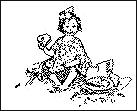
|
Those
Were The Days by Lillian Hein
Remmick: Index Page
|
Lillian: You have the recorded tape with Mother when she describes the Hein cellars in Borodino.
Judy: Yes. And, I, also, have her drawings of the Hein wine cellar.
|
In Borodino / Bess. S. Russia, Michael Hein's wine barrels were about 40 feet tall and were made of redwood from California. The masonary was by a Hein family who lived in Neudorf. They were very good. I think some of them had built wine cellars in the Crimea. |
Lillian: Dad [Ludwig Hein] said that there were Heins who were
masons who lived in a nearby village [Neudorf /Od] who used bricks to make
great grandfather's [Michael Hein's] wine cellar.
Judy: I remember Grandma saying the redwood used for the huge wine barrels was shipped in from California. Whenever I had gone through a winery on tour they always talked about oak barrels so it seemed Grandma wasn't remembering accurately. Maybe, she meant oak from California.... Lillian: They had oaks in Bessarabia. The largest oak Borodino was in the front yard of Grandpa Michael Hein. Judy: When I was on our last tour of a winery in Napa, I asked the fellow if redwood was ever used for wine. He said, "The big container barrels were redwood in the old days." He told me other things but I've forgotten .Lillian: Mother and Dad said they were 40 feet tall. Ed: That tall! |
Lillian: Remember Mrs. Kranzler. She talked about how she rememberd Grandpa Michael Hein sitting and counting his money all day. He had all this money in a different kind of cellar. It was more like a bank vault under the ground. The entry was different. It was above ground and steps going down instead of a ladder. They also had their root cellar where root vegetables and grandma Hein's [Christina, nee Stehr., Hein] canning was kept. I don't know if she canned. She had hired help. We had helped, too. I couldn't tell you how many jars I've canned. I hated canning the tomatoes....
Judy: I remember in the summer when the canneries were running tomatoes. I hated that hot tomato smell as they dipped the tomatoes in boiling water to skin them..... I ride my bike down the street at the smell would following be through the sewers that steamed from the hot water escaping the canneries. Was I glad when you discovered you could can the tomatoes with the skins on and through the hot bath of the canning you realized the skins would pop off and end up on the bottom of the jars.
Ed: Must be time for me to go see to the goats.
Judy: Dad. The cellars in Streeter... Were they dirt?
Ed: Yes. The walls and the floor were.
Judy: How big?
Ed: It was the size of ..... Oh, I'd say twelve, maybe, fifteen feet deep, or a little more. About twenty feet long..... Not sure how wide. Maybe fifteen feet. Some were smaller, some were larger.... It was cool down there in the summer.... The house was above.
Lillian: Remember, the basement under our house near Marsh was the old Lone Tree Fort so it's basement was huge. Like the rooms upstairs. It hadn't been built to be a home....
Judy: What held up the ceiling in your cellar in Streeter, Dad?
Ed: The beams and the flooring of the house.
Judy: So the floor of the house above was wood?
Ed: Sheets of wood under the rubbery stuff that was pre-linoleum ...
------
The conversation then lead us into the flooring of their homes in N. Dakota, Montana and Russia.
![]()
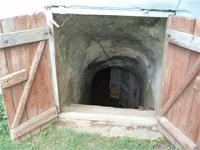 Celler
which once belonged to Friedrich Hein of Borodino / Bess. S. Russia
[Ukraine]
See
larger photo and more information in Alfred Hein's Photo
collection.
Celler
which once belonged to Friedrich Hein of Borodino / Bess. S. Russia
[Ukraine]
See
larger photo and more information in Alfred Hein's Photo
collection.
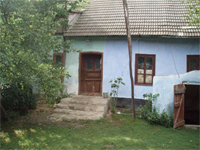 <<
You can see the entrance to the celler in this photo in the lower right
hand corner.
<<
You can see the entrance to the celler in this photo in the lower right
hand corner.
![]()
There is an article about the Haas Family Root Cellar by Roger Haas found in articles in NDSU. It was built around the 1900s by Daniel Haas on the family farm near Zeeland, ND, USA.
![]()
Garry Hubert: : You have a picture of the cellar in Norway where the beam has the carved year the of 1711. The main cellar was under the old farm house of Mysvold. And, the second one was the summer small root cellar. I think there is one of my mother as a child with her cousins around that same root cellar.
Judy A. Remmick-Hubert: Garry went inside and took a photograph looking out. He said it sloped into the ground and he couldn't quite stand up inside. Garry is 6 feet 3+ inches tall. He said it was cool even though there was no longer a door attached. Accept for a period of time when the area was held by monks, Garry's family has owned the land since the early 800s and probably earlier.

It appears that cellars wherever the earth permitted, cellars have been built by our ancestors. The kind of cellar was generally the same. It was made of earth and usually under a home /dwelling. Some cellars were elaborate and depended upon the wealth of the landowner. But for the most part, a cellar was simple. There were usually some shelves, containers of different kinds and food was kept here to store and keep at a cool temperature. When Napoleon's man discovered he could keep peas in a jar with a seal, others took up the method and canning began. So, the shelves were filled with canned goods. In modern times, most glass jars are clear glass. I remember the old blue tinted mason jars. There were some jars that held a gallon. Most jars were quarts. James and jellies usually went into pint size jars. Lodi, where I grew up, there were a few cellars under the older houses. We had one under the old apartment building on 303 Vine. It belonged to the owner so I was down inside maybe once or twice. We didn't have any cellars under any the houses I later resided. Nor did any of my grandparents when I was old enough to build memories. When we visited Montana or Dakotas, everyone had cellars. They were used not only for storage of food, they were used as a place to survive tornados that leveled homes..... I've never seen a modern home in California built with a cellar. With refrigeration, cellars are no longer needed to store food. I doubt my California born and raised children have ever been in a cellar. Obviously, back before refrigeration, cellars were necessary for survival for our ancestors no matter where they lived.

Pfaff Index. Page |
Hubert Home Site |

|
|